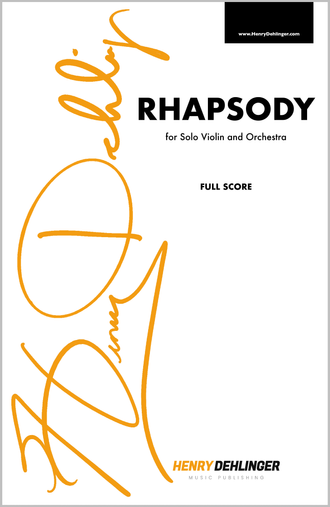

Rhapsody (2021) - 16'
for solo violin and orchestra
2(pic).2(corA).2.2 - 4.2.2.1 - timp.3perc - hp - s.vln - str
COMPOSER'S NOTE
I first met violinist Gil Shaham backstage at the National Philharmonic’s 2021-22 season opening concert. A work of mine, The Love Song of J. Alfred Prufrock, a rhapsody for voice and orchestra, had just made its premiere. It was intermission, and Gil was preparing to take the stage for Beethoven’s Violin Concerto in D Major.
Gil is known for his warmth and generosity of spirit. These hallmark virtues are as evident in his personal manner as in his performance. After hearing Prufrock, he encouraged me to write a work for solo violin.
We stayed in touch. I studied his many performances on YouTube—violin concertos by Mendelssohn, Brahms, Tchaikovsky, Bruch, Barber (one of my personal favorites), and more. In each, he penetrates to the very heart of the work. For Gil, virtuosity is not merely a technical matter. It is a compelling balance of precision and emotion few performers ever master.
The result is my Rhapsody for Solo Violin and Orchestra (2022), replete with scalar runs, double stop trills, intricate cadenzas and a dramatic coda that celebrate Gil’s improvisational virtuosity.
The rhapsody is a form with which I'm familiar. Prufrock is a rhapsody. Typically, it is an episodic, one-movement work with a wide range of contrasting moods, colors, and even musical styles. It should evoke a sense of improvisation and spontaneous inspiration.
It opens with a percussive burst punctuated by a Bartók pizzicato in the double bass. The violin solo introduces an arousing melody supported by a fast-paced, rolling rhythmic pattern common in Middle Eastern music and counted one-two-three, one-two-three, one-two. The rhythm is tapped out with the claves, a pair of wooden sticks popular in Afro-Cuban music.
Meanwhile, the violin solo embarks on a fifteen-minute lyrical odyssey from anxious to yearning, tender to ethereal, comical to martial. There are three cadenzas along the way.
At last, we are led to a triumphant coda where the violin sings high above the din of a tutti C minor seventh. The ensemble sweeps to a fort-fortissimo D major climax—enhanced by an exotic sounding minor second—as our rolling rhythmic pattern returns for one last hurrah.
